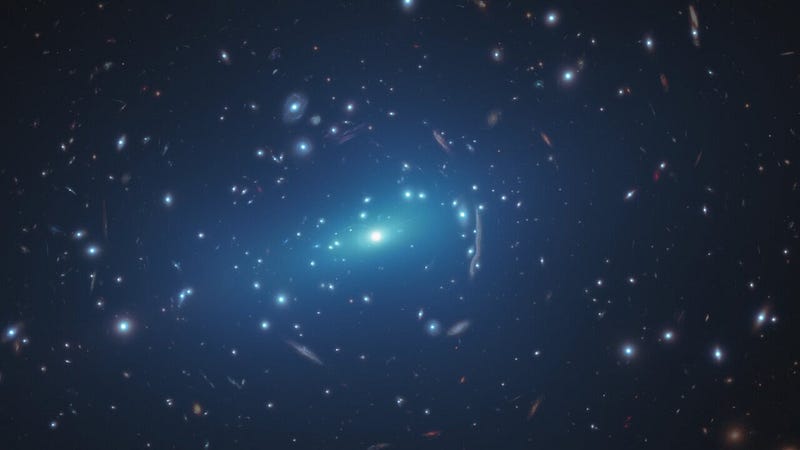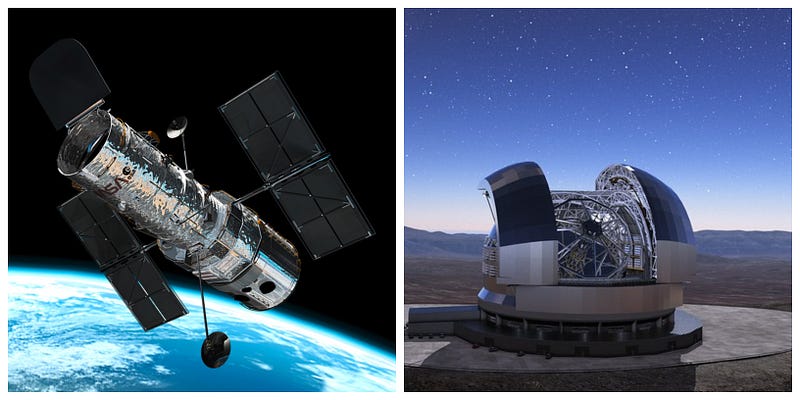# New Insights on Dark Matter from Hubble and VLT Observations
Written on
Understanding Dark Matter
Our grasp of dark matter has taken another intriguing turn, adding complexity to this cosmic enigma. Dark matter constitutes the majority of matter within the Universe, yet remains largely elusive. This "dark" substance cannot be detected through light or any form of electromagnetic radiation; however, it does exert gravitational forces that are essential for keeping galaxies and their clusters intact.
Recent research, based on observations of far-off galaxy clusters captured by the Hubble Space Telescope and the Very Large Telescope (VLT) in Chile, indicates that dark matter may not behave as previously predicted by simulations, hinting that our current models require adjustments.

The initial observations were inspired by Fritz Zwicky, who, in 1933, analyzed the Coma galaxy cluster. He noted an insufficient amount of visible matter to account for the gravitational binding of the galaxies. This led him to propose the existence of unseen matter — now known as dark matter.
In the 1970s, Vera Rubin utilized the Kitt Peak Observatory's 2.1-meter telescope to investigate the rotational velocities of galaxies, confirming that dark matter exists both within galaxies and in the spaces between them. It also plays a crucial role in the Universe's large-scale structure, forming vast filaments of galaxies that stretch across the cosmos.
Dual Perspectives on Dark Matter

Since dark matter is invisible, astronomers examine the ordinary matter surrounding it, measuring how it is influenced by the gravitational pull of this unseen force. One effective method for studying dark matter is gravitational lensing, which occurs when light from distant galaxies is distorted as it passes through a mass of dark matter, potentially amplifying or creating multiple images of faraway objects.
In a recent study, astronomers scrutinized 11 distant galaxy clusters with data from both the Hubble Space Telescope and the VLT. These clusters are abundant in dark matter, both on small and large scales.

The collaboration of Hubble's sharp imagery and VLT's advanced spectral analysis enabled a deeper investigation into these remote galactic formations. The observations unveiled numerous background targets whose light paths were bent by dark matter, allowing researchers to map the distribution and density of this invisible substance. The findings indicated that the gravitational lensing effects from small-scale dark matter clumps are ten times stronger than earlier predictions.
Priyamvada Natarajan, an astrophysicist at Yale University, expressed her excitement about the significant discrepancy between observations and theoretical expectations: “Detecting such a substantial gap — a factor of ten in this case — between what we observe and what we predict is thrilling… These anomalies often signal that we may be overlooking something fundamental in our current theories or suggest the need for a completely new model.”
“In spiral galaxies, the proportion of dark to light matter is roughly ten to one. This might serve as a fitting metaphor for our current understanding versus ignorance. While we've progressed beyond the basics, we still have much to learn," Vera Rubin noted.
This research also revealed nested images, akin to Russian Matryoshka dolls, hinting at a potential gap in astronomers' current comprehension of dark matter.
“The observed cluster substructures serve as more efficient gravitational lenses than predicted by Cold Dark Matter simulations, exceeding expectations by over tenfold. This discrepancy could stem from either systematic issues with the simulations or incorrect assumptions regarding dark matter's properties,” the study's authors stated in their article published in Science.
Spectroscopic data from the VLT allowed scientists to gauge the velocities of individual stars within these galaxy clusters, enabling them to estimate the total mass, including dark matter, present in these distant formations. “Our thorough comparisons between simulations and observational data reveal persistent mismatches. One possibility for this discrepancy could be the omission of crucial physics in our simulations,” remarked Massimo Meneghetti from the INAF (National Institute for Astrophysics)-Observatory of Astrophysics and Space Science of Bologna in Italy.
By integrating various telescopes and analyzing light across multiple frequencies (such as radio, infrared, and ultraviolet), astronomers can piece together the processes occurring in and around these distant cosmic targets. For instance, a supernova will emit high-energy radiation like gamma rays and X-rays before transitioning to visible light, infrared, and radio waves as it cools. Collecting data across all these frequencies allows for a comprehensive understanding of cosmic events.
Looking ahead, the Nancy Grace Roman Space Telescope, set to launch in the mid-2020s, aims to explore even more distant galaxy clusters, further unraveling the mysteries of dark matter.
James Maynard is the founder and publisher of The Cosmic Companion. A native of New England, he now resides in Tucson with his wife, Nicole, and their cat, Max.
Did you enjoy this article? Join us on The Cosmic Companion Network for our podcast, weekly video series, informative newsletters, news briefings on Amazon Alexa, and more!
Chapter 2: Dark Matter Mysteries
The second video, titled "Dark Matter — The Greatest Mystery of The Universe," delves into the profound questions surrounding dark matter and its implications for our understanding of the cosmos.